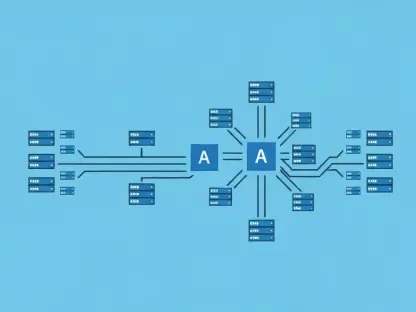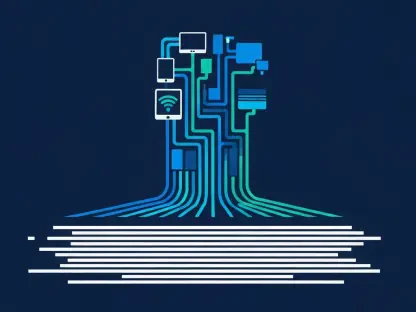China’s ambitious efforts to eliminate poverty and promote socialism have taken a unique turn by incorporating big data and cybernetics into their strategies. The blend of technological advancements with socio-economic policies has led to significant improvements in the living standards of millions.
China’s Targeted Poverty Alleviation Program
Comprehensive Scope and Financial Investment
China’s targeted poverty alleviation program, which began in 2013, showcases the country’s substantial financial commitment, evidenced by the allocation of $246 billion. The Chinese government’s resolve to confront poverty head-on is seen in this massive investment, aimed not just at short-term relief but at long-term structural transformation. This program is one of the largest coordinated efforts globally, reflecting the scale of China’s ambition in tackling poverty through detailed planning and financial backing.
This financial injection has laid the groundwork for extensive infrastructural improvements across rural China, highlighting the depth of the initiative. The development includes building nearly 700,000 miles of rural roads, dramatically improving connectivity between remote villages and urban centers. These roads are critical for fostering economic activity, facilitating the transport of goods, and improving access to services, effectively closing the urban-rural divide. By investing heavily in infrastructure, China aims to create an environment where economic activities can thrive, thereby providing a strong foundation for sustainable poverty alleviation.
Modernizing Rural Infrastructure
The modernization of rural infrastructure is a cornerstone of China’s poverty alleviation program, demonstrating the government’s commitment to achieving comprehensive socio-economic development. This concerted effort has extended internet access to 98% of the country’s poor villages, bridging the digital divide that has long hampered rural areas. The expansion of internet access is not merely about connectivity but serves as a tool for education, healthcare, and economic opportunities, thus integrating these communities into the broader national and global economies.
Moreover, the program has renovated homes for over 26 million people and built new housing for almost 10 million, reflecting a holistic approach to improving living conditions. Providing safe and modern living spaces addresses fundamental human needs and instills a sense of dignity and security among the rural population. These efforts are a testament to the government’s resolve to uplift the living standards in underdeveloped areas, ensuring that infrastructure improvements translate into tangible benefits for the residents. This modernization is foundational in creating environments conducive to economic growth and overall societal well-being.
Multidimensional Poverty Approach
Multidimensional poverty measures poverty using various indicators that capture the many facets of the experience of poverty, going beyond income-based measurements. This approach recognizes that poverty involves a collection of different deprivations that a person may face, such as poor health, lack of education, inadequate living standards, disempowerment, poor quality of work, and threat from violence.
One Income, Two Assurances, and Three Guarantees
China’s multifaceted approach to poverty is encapsulated in its slogan “one income, two assurances, and three guarantees.” This comprehensive framework is designed to address various dimensions of poverty, ensuring that the needs of the poorest and most vulnerable populations are met. The strategy sets out to raise daily incomes above the UN poverty line of $1.90, providing a significant economic boost to millions. By focusing on income elevation, the program aims to offer a sustainable pathway out of poverty, encouraging economic self-reliance and growth.
Additionally, the “two assurances” guarantee food and clothing availability, ensuring that basic necessities are consistently met, thereby improving the quality of life. The “three guarantees” focus on providing access to basic medical services, safe housing, and free education. Clean drinking water and electricity are also assured under this framework, reflecting an integrative approach to addressing the myriad challenges faced by impoverished communities. This multidimensional strategy ensures that poverty alleviation efforts are comprehensive and far-reaching, targeting both immediate needs and long-term development goals.
Impact on Individuals
The transformative impact of China’s poverty alleviation program is vividly illustrated through individual stories, such as that of Peng Lanhua from Guizhou Province. Her life-changing experience serves as a compelling example of how targeted governmental interventions can drastically alter living conditions for the better. Peng previously lived in a dilapidated home, but through the poverty alleviation initiative, her residence now includes modern amenities such as a concrete floor, shower, toilet, and hot water. These improvements go beyond physical enhancements; they significantly elevate the standard of living and well-being.
Such individual-focused interventions underscore the government’s commitment to improving living standards facilitated by meticulous data collection and analysis. This personalized approach ensures that each community’s unique needs are met, enabling tailored solutions that directly address specific challenges. Peng’s story is one among millions, highlighting the program’s effectiveness in creating tangible, life-altering changes for the most disadvantaged populations. This personalized approach stands as a testament to the power of targeted and data-driven interventions in achieving widespread socio-economic improvements.
Big Data and Cybernetics in Poverty Alleviation
Deployment of Communist Party Cadres
The integration of big data and cybernetics in China’s poverty alleviation efforts hinges on the extensive deployment of nearly three million Communist Party cadres across the country. These cadres conducted household surveys, gathering invaluable data on the living conditions and specific needs of rural populations. This massive data collection exercise is unprecedented, highlighting the government’s commitment to understanding the granular details of poverty throughout the country. The cadres’ efforts provided a comprehensive data set, forming the foundation for informed decision-making and targeted interventions.
This groundwork enabled a granular understanding of poverty issues tailored to specific communities, revealing the intricate web of challenges faced by individuals. The level of detail obtained from these surveys allowed for the creation of precise and effective solutions, addressing the unique needs of each community. By leveraging the vast network of Communist Party cadres, the government ensured that data collection was not only thorough but also consistent across different regions, thereby creating a robust framework for implementing targeted poverty alleviation strategies.
Analysis and Tailored Interventions
Extensive data collection allowed for precision-targeted interventions, resulting in effective solutions designed to meet the unique needs of individuals and communities. This strategic approach is a hallmark of China’s use of big data and cybernetics in its poverty alleviation program. By analyzing the data collected, the government could identify specific areas where interventions would be most impactful. This data-driven methodology ensures that resources are allocated efficiently, maximizing the benefits and achieving the desired outcomes.
For instance, in rural areas where access to clean drinking water was identified as a significant issue, the government implemented specialized initiatives to improve water safety standards. In regions where healthcare accessibility was lacking, targeted programs were introduced to enhance medical services. These tailored interventions demonstrate the program’s flexibility and responsiveness, allowing for real-time adjustments and improvements based on continuous data analysis. This adaptive approach ensures that poverty alleviation efforts remain relevant and effective, evolving to meet the changing needs of the population.
Historical Context
Soviet Union’s and Chile’s Cybernetic Systems
China’s use of cybernetics and big data in its poverty alleviation strategy draws parallels with historical precedents, such as the Soviet Union’s All-State Automated System (OGAS) and Chile’s Cybersyn project. These instances highlight early attempts to leverage cybernetics for social planning, providing valuable lessons and insights. The Soviet Union’s OGAS aimed to create a comprehensive network for resource allocation and economic planning across the nation. Although it was never fully realized, the OGAS project underscored the potential of cybernetics in managing complex socioeconomic systems.
Similarly, Chile’s Cybersyn project, initiated under President Salvador Allende, represented an innovative effort to use cybernetic principles for economic management. The project sought to handle economic disruptions by utilizing real-time data and communication networks. However, its potential was cut short by the CIA-backed coup in 1973. These historical projects, despite their incomplete implementation, laid the groundwork for understanding the capabilities and challenges of employing cybernetics in socio-economic planning. By studying these precedents, China could refine and adapt these principles in its own poverty alleviation efforts, ensuring a more successful implementation.
China’s Sustained Implementation
Unlike its predecessors, China has effectively implemented and sustained cybernetic strategies at a national scale, integrating them into both private sector efficiencies and public welfare initiatives. This successful integration reflects a deep understanding of the lessons learned from earlier attempts, allowing for a more nuanced and adaptive approach. China has managed to overcome the operational and political challenges that hindered previous efforts, creating a robust framework for utilizing cybernetics in its socio-economic strategies.
The sustained implementation of cybernetic systems in China emphasizes the dual application of these technologies for both economic and social benefits. In the private sector, advanced cybernetic systems optimize production and distribution, enhancing overall efficiency. This optimization contributes to economic growth, creating material wealth necessary for social programs. Concurrently, the public sector adapts these technologies for societal benefits, employing them in poverty alleviation strategies to improve the quality of life for millions. This dual application not only maximizes the utility of cybernetics but also ensures that technological advancements are harnessed for the broader goal of societal welfare.
Dual Application of Cybernetics
Private Sector Optimization
No errors detected
The private sector in China plays a crucial role in the dual application of cybernetics, utilizing advanced systems to optimize production and distribution. By leveraging big data and cybernetic principles, businesses can streamline their operations, reduce waste, and enhance efficiency. This optimization is vital for fostering economic growth, as it allows companies to operate more sustainably and profitably. The competitive advantage gained from these technologies also propels China to the forefront of global industries, creating additional economic opportunities and resources.
Moreover, the success of cybernetic systems in the private sector serves as a blueprint for public sector applications, demonstrating the potential of these technologies in various contexts. The expertise and innovations developed within the private sector can be adapted for public welfare, creating a symbiotic relationship between economic growth and social development. This pragmatic approach ensures that technological advancements contribute to the broader goal of building socialism, as economic resources generated through private sector efficiencies are redirected towards societal benefits.
Public Welfare and Societal Benefits
The public sector’s adaptation of cybernetic systems for societal benefits highlights China’s innovative approach to poverty alleviation. By employing these advanced technologies, the government can design and implement targeted interventions that address specific social challenges. The precision and efficiency of cybernetic systems allow for the effective allocation of resources, ensuring that the most pressing needs are met. This approach reflects the propositions suggested in books like “The People’s Republic of Walmart,” which argue that technological advancements in the private sector could potentially be harnessed for more egalitarian, socialist ends.
One notable example is the “Guizhou Poverty Alleviation Cloud” system, which integrates data from various governmental departments to optimize resource allocation. This centralized data management system allows for precision-targeted actions, ensuring that interventions are tailored to the needs of specific communities. By leveraging big data and cybernetics, the public sector can continuously monitor and adjust its strategies, creating a dynamic and responsive framework for poverty alleviation. This innovative approach demonstrates the potential of integrating technology with public policy to address complex socio-economic challenges effectively.
Cybernetics with Chinese Characteristics
Integration of Capitalist and Socialist Mechanisms
China’s approach to cybernetics and poverty alleviation is characterized by the seamless integration of capitalist efficiencies with socialist objectives. This pragmatic application aligns with historical Marxist thought, where Engels and others posited that socialism could only be effectively built atop a sufficiently developed capitalist economy. By encouraging private markets to spur economic growth, China accumulates the necessary material base to transition to socialism. This approach ensures that economic development and social welfare are not mutually exclusive but complementary aspects of a cohesive strategy.
The combination of capitalist mechanisms and socialist goals is evident in policies that promote economic growth while addressing social disparities. For instance, the government encourages technological innovation and private sector efficiencies, generating wealth that can be redistributed through social programs. This dual approach ensures that the benefits of economic growth are felt across all segments of society, creating a more equitable and sustainable development model. By integrating capitalist efficiencies with socialist aims, China demonstrates a unique and effective approach to achieving its socio-economic goals.
Centralized Data, Decentralized Implementation
The cybernetic poverty alleviation strategy in China is characterized by centralized data management and decentralized implementation. Centralized data systems, such as the “Guizhou Poverty Alleviation Cloud,” play a crucial role in collecting, analyzing, and managing vast amounts of information from various sources. This centralized approach ensures that data is accurate, up-to-date, and readily accessible, forming the basis for informed decision-making and strategic planning. By integrating data from multiple governmental departments, these systems provide a comprehensive overview of the socio-economic landscape.
Decentralized implementation, on the other hand, ensures that interventions are tailored to the specific needs of local communities. Local authorities and grassroots organizations use the data provided by centralized systems to design and execute programs that address the unique challenges faced by their regions. This decentralized approach allows for flexibility and adaptability, ensuring that solutions are relevant and effective. By combining centralized data management with decentralized implementation, China’s poverty alleviation program can achieve a high level of precision and efficiency, maximizing the impact of its interventions.
Infrastructure and Livelihood Improvements
Enhanced Standards and Accessibility
The successful implementation of China’s poverty alleviation program is evident in the significant improvements in infrastructure and overall living standards. Enhancing drinking water safety standards, improving accessibility to medical services and education, and ensuring food security are among the notable achievements. These improvements address the fundamental needs of the population, creating a foundation for sustainable development. By prioritizing these essential services, the government ensures that the basic quality of life is elevated across impoverished regions.
Accessibility to medical services and education has been a critical focus of the program. By improving healthcare infrastructure and services, the government ensures that rural populations have access to necessary medical care, reducing health disparities and improving overall well-being. Similarly, enhancing educational opportunities in rural areas empowers individuals with the knowledge and skills needed to break the cycle of poverty. These concerted efforts create a more equitable society, where all citizens have access to the resources and opportunities needed to thrive.
Statistical Evidence of Success
China has taken an innovative approach to addressing poverty and advancing socialism by integrating big data and cybernetics into its methods. By leveraging these technological advancements, China has achieved notable progress in enhancing the living standards of its population.
This approach marks a departure from traditional socio-economic strategies. It involves collecting vast amounts of data on individuals’ living conditions, employment, healthcare, and education. By analyzing this data, the government can tailor its policies more precisely to target the root causes of poverty and implement more effective interventions.
For example, big data analytics can identify areas where job creation programs are most needed or where healthcare services are lacking. Cybernetic systems can ensure efficient distribution of resources and provide real-time feedback on the effectiveness of various initiatives. This data-driven approach allows for a dynamic and responsive governance model, where adjustments can be made swiftly to address emerging challenges.
The integration of technology into these efforts has led to substantial improvements in the quality of life for millions of people. Housing conditions have improved, access to education has expanded, and healthcare services have become more accessible. By using data to drive their policies, China is steering a path that combines socialism with the precision of modern technology, aiming to create a more equitable and prosperous society.









